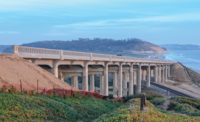Numerous big highway projects around the state are helping to keep things moving as the construction industry continues to dig out of the recession.
And while most of these projects are being funded by traditional tax and bond measures, many are being infused with funds from American Recovery and Reinvestment Act of 2009.
�The impact of the stimulus has been huge,� says Earl Seaverg, Caltrans program manager for the recovery act. �It�s been able to help us fund and move stalled projects to construction that would have otherwise remained on the shelf due to the downturn in the economy.�
Caltrans received $2.54 billion (more than any other state) in ARRA funds, which have been designated to 907 projects. Of these, 516 projects worth $2.5 billion have been awarded contracts to begin work and about 111 are currently under way.
�From day one, our focus has been and continues to be getting stimulus dollars out to transportation projects quickly to spur job growth and ensure that California gets the maximum benefit from the Recovery Act,� says Randy Iwasaki, former Caltrans director.
One of the largest recovery act projects is the $1.3-billion Interstate 405 Sepulveda Pass project in Los Angeles, which received about $190 million in ARRA funding.
The project is led by both the Los Angeles Metropolitan Transportation Authority and Caltrans as owner/engineer. General contractor is Kiewit Pacific Co. of Santa Fe Springs.
The design-build job will add a 10-mi HOV lane on the northbound side of the San Diego (I-405) Freeway from the Interstate 10 to the Ventura (U.S. 101) freeways, one of the busiest freeway areas in the nation.
Michael Barbour, Metro�s project director, says that while most of the work is being performed at night to reduce effects on traffic, the impacts to motorists and neighboring communities will be the biggest challenge over the next three years.
This project is like �performing heart surgery on a patient while she runs a marathon,� Barbour says. �Widening and improving one of the nation�s most congested highways � while keeping it operating � will mean inconvenience and delays for residents and businesses neighboring the 10-mile-long project, not to mention commuters.
�However, this is a short-term-pain, long-term-gain situation. When it�s completed, this project will complete the HOV lane network on the northbound I-405 and, consequently, improve traffic flows in the region.�
Crews are currently demolishing and reconstructing the Sunset Bridge in West Los Angeles. There are two additional bridges, Skirball and Mulholland, that also will be taken down and rebuilt as part of the project. Construction began in mid-January and is scheduled for completion in 2013.
The only project in the state to garner more ARRA money than the 405 Sepulveda Pass is the $420-million Caldecott Tunnel Project in Alameda County, which pulled in $192 million in recovery funds.
Another big project assisted by ARRA funding is the $1-billion Presidio Parkway, which got $168 million from the program. This 1.5-mi-long project replaces Doyle Drive, a portion of Route 101 within the Presidio of San Francisco, and transforms it into a new urban roadway called Presidio Parkway.
Also in Northern California, Longmont, Colo.-based Flatiron Corp. is general contractor on the $59-million Interstate 880 High Street Bridge Replacement in Oakland. Caltrans is serving as owner.
The project, which received no ARRA funds, consists of reconstructing and widening the bridge over I-880 at High Street and demolishing the existing northbound and southbound bridges. The project, Flatiron�s fourth along I-880, broke ground last fall and is expected to complete in summer 2011.
�This is a tricky project that needs a lot of coordination because it is in downtown Oakland, over some heavily traveled roads, in tight quarters,� says Curt Weltz president of Flatiron�s Western Region, which covers eight states
A project that is completely funded by ARRA money is the $48-million State Route 91 lane addition in Orange and Riverside counties. Led by Fontana-based Brutoco Engineering & Construction, the pavement reconstruction consists of adding one lane on eastbound SR-91 from SR-241 to SR-71 and the widening of all lanes and shoulders.
�This project is challenging because it was bid with an extremely tight, 10-month time frame,� says Michael Murphy, Brutoco president. �We are doing freeway closures, working a lot of nights, weekends and extended shifts. With the partnering and cooperation between Caltrans, OCTA and Brutuco, we�ve been able to maintain the schedule.�
The project broke ground in November and is slated to finish in the fourth quarter of this year.








Post a comment to this article
Report Abusive Comment